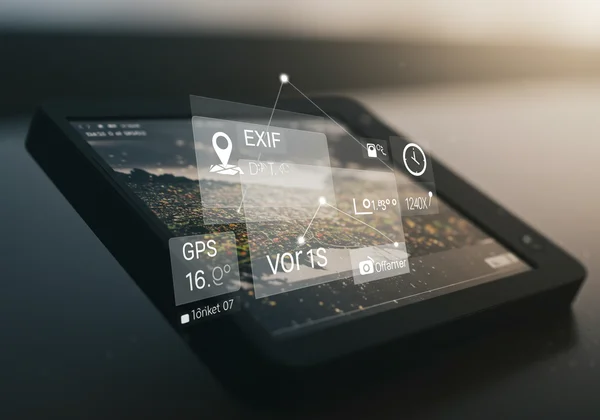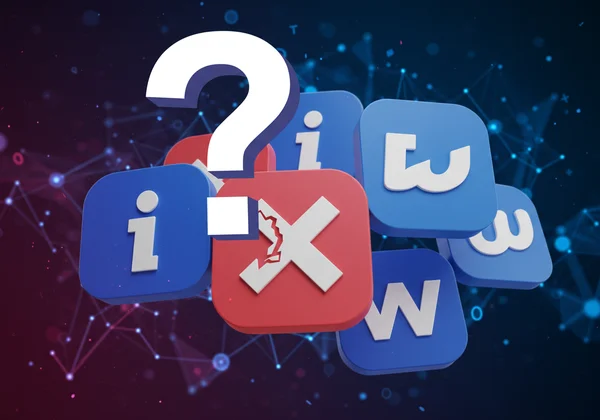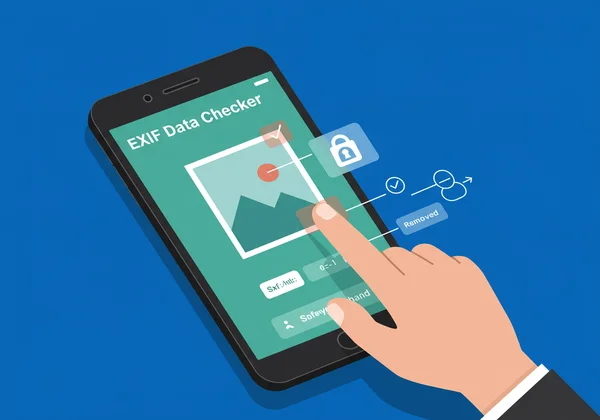在线安全分享照片:您的终极 EXIF 隐私指南
您在线分享的每张照片都在讲述一个故事,但有时,它会透露出比您预期更多的信息。隐藏在您珍贵回忆中的是数字痕迹——EXIF 数据——它可能会泄露您的私人详细信息。本指南将帮助您理解和控制这些数据,确保您安全地分享照片并保护您的隐私。本指南将帮助您在线 安全分享照片。在您发布下一张照片之前,您是否曾问过: 什么是 EXIF 数据?
本指南将揭示嵌入您图像中的不可见数据,阐明您可能面临的隐私风险,并赋予您重新掌控的权力。我们将探讨如何通过简单的分享前检查来保护您的个人信息。您现在就可以使用 免费在线工具 来查看您的照片正在泄露哪些信息。
什么是 EXIF 数据以及您的照片为何在线泄密?
可交换图像文件格式 (EXIF) 数据,其核心是您的相机或智能手机自动附加到您拍摄的每张照片上的元数据。可以将其理解为一个包含丰富信息的数字标签。虽然它对于组织您的照片库或帮助摄影师分析其作品非常有用,但如果未经仔细考虑而分享,这些数据可能会成为严重的隐私问题。
每次点击中的隐藏信息:位置、相机、时间
这些 隐藏信息 远不止基本的文件属性。一张图像可以包含数十个数据点,创建一个关于其拍摄时刻的详细剖面。一些最常见和敏感的详细信息包括:
- GPS 坐标: 照片拍摄时的精确纬度和经度。这可以以惊人的准确度定位您的家、工作地点或您孩子的学校。
- 日期和时间: 不仅仅是日期,还有快门按下时的精确秒数。
- 设备详细信息: 您的相机或智能手机的品牌和型号(例如,Apple iPhone 14 Pro,Canon EOS R5)。
- 相机设置: 技术细节,如 ISO、光圈、快门速度和焦距。
- 唯一标识符: 有时,甚至会包含相机或镜头的序列号。
这些数据本意是提供帮助,但当公开分享时,它们可能会被利用。要亲自查看这些信息,您可以 即时查看 您任意一张图像中的数据,而无需上传。

分享未经处理照片的隐私风险
隐私风险 并非理论上的;而是切实存在的,并且会立即产生影响。分享带有完整 EXIF 数据的照片可能会无意中将您暴露于跟踪、数字监视甚至人身威胁。一张您家中新宠物的照片可能会泄露您的家庭住址。一张生日派对的照片可能会告诉陌生人您庆祝个人事件的确切地点和时间。对于注重隐私的个人而言,理解和管理这些数据是维护数字安全的不可或缺的一步。

解读社交媒体:哪些平台会删除(或保留)您的 EXIF 数据
一个常见的误解是,社交媒体平台会自动删除照片中的所有元数据来保护用户。虽然大多数主流平台确实会从其公共动态中显示的图像中删除 一些 数据,但现实情况比您想象的要复杂且不那么安全。仅仅依赖它们是一种冒险。
Instagram 和 Facebook:分享照片,守护秘密?
谈到 Instagram EXIF 数据 和 Facebook 照片隐私,这两个平台通常会从其他用户在其动态中看到的照片版本中删除大部分 EXIF 数据,包括 GPS 坐标。然而,这并不意味着数据消失了。他们仍会处理并存储您上传的原始文件及其所有元数据。他们可能会将这些数据用于自己的分析和定向,并且政策可能会在不另行通知的情况下发生变化。
X (Twitter)、WhatsApp、Discord 及其他平台:元数据快速概览
其他平台对元数据的处理方式差异很大:
- X(前身为 Twitter): 与 Facebook 类似,X 会从平台上显示的图像中删除 EXIF 数据。
- WhatsApp: 会压缩图像并通常删除大部分元数据以节省带宽,但不同版本和操作系统之间的做法可能会有所不同。
- Discord: 通常会从上传的图像中删除元数据。
“自动删除”的迷思:为何您不能总是信任平台
以下是关键要点:“删除”并不总是彻底的,而且它只有在您已将私人数据发送到公司服务器 之后 才会发生。此外,如果有人直接从链接或通过某些方法下载原始文件,元数据可能仍然完好无损。唯一能百分之百确定您的私人信息未被共享的方法是,在您上传 之前 亲自检查和管理它。使用 隐私优先工具 是唯一能确保您保持控制的方式。

如何删除 EXIF 数据:您的分享前隐私清单
掌控您的照片隐私比您想象的要容易。通过将简单的检查融入您的分享习惯中,您可以自信地发布内容。目标是 删除 EXIF 数据,或者至少在照片离开您的设备前,了解您正在分享的内容。这是负责任的数字公民的基石。
逐步操作:使用在线工具删除元数据
检查照片元数据最安全、最直接的方法是使用尊重您隐私的工具。虽然存在许多工具,但选择一个在您的浏览器中本地处理图像的工具至关重要。这确保了您的敏感照片永远不会上传到第三方服务器。
我们的平台正是基于这一原则构建的。以下是您如何使用它:
- 访问网站: 在您的电脑或移动设备上访问 EXIFData.org。
- 选择您的照片: 将图像文件拖放到页面上,或点击选择您设备中的文件。
- 即时查看数据: 该工具将立即显示所有嵌入的 EXIF 数据,而无需上传您的文件。所有操作都在您的浏览器中进行。
通过首先查看数据,您可以决定照片是否可以按原样安全分享,或者您是否需要采取措施将其删除。

桌面和移动设备上的 EXIF 删除方法
大多数操作系统都有内置的元数据删除方法:
- 在 Windows 上: 右键点击照片文件,选择
属性>详细信息,然后点击删除属性和个人信息。 - 在 macOS 上: 在
预览应用中打开照片,前往工具>显示检查器,然后导航到 GPS 选项卡以删除位置数据。
虽然这些方法有效,但它们可能很繁琐。首先使用专用的在线查看器是评估需要删除哪些内容的最快方法。
黄金法则:分享前务必检查
养成习惯。在您点击“发布”、“发送”或“上传”之前,花 30 秒钟通过安全查看器检查您的照片。这个简单的步骤将您从被动的数据分享者转变为积极主动的隐私守护者。
自信分享:您的数字隐私之旅
通过对 EXIF 数据的清晰理解,您现在有能力重新掌控您的数字隐私。嵌入在照片中的不可见信息不必成为一种负担。通过了解风险并采纳“分享前检查”的简单心态,您可以继续安心地捕捉和分享您生活中的精彩瞬间。
您现在拥有了保护自己的知识和工具。您的安全在线分享之旅从下一张照片开始。我们鼓励您 试用我们的工具,亲眼看看您的图像中隐藏着什么秘密。与朋友和家人分享本指南,让我们共同努力,创建一个更安全、更私密的数字社区。
关于 EXIF 数据和在线照片分享的常见问题
EXIF 数据总是显示我的精确 GPS 位置吗?
不,并非总是如此。只有在拍摄照片时您的相机或智能手机启用了定位服务,GPS 数据才会被记录。然而,一旦存在,它往往会惊人地准确。最好始终使用像 我们的安全查看器 这样的工具检查您的图像,以确保安全。
截图或下载的图像包含 EXIF 数据吗?
通常,截图不包含与相机拍摄的照片相同的丰富 EXIF 数据,因为它们捕获的是屏幕上的像素,而不是来自相机传感器的数据。然而,它们确实包含一些元数据,例如创建日期和设备信息。从大多数社交媒体网站下载的图像会删除其原始 EXIF 数据,但从其他来源(如个人博客或云存储链接)下载的图像可能仍包含完整、原始的元数据。
在线从我的照片中删除 EXIF 数据的最简单方法是什么?
最简单和最安全的方法是首先查看数据,了解其中包含哪些信息。使用注重隐私的在线查看器,您可以即时查看所有元数据,而无需上传文件。一旦您知道存在哪些数据,您就可以使用操作系统的内置工具或其他软件在分享之前将其删除。
如果我裁剪照片,EXIF 数据会改变吗?
裁剪或编辑照片有时可能会更改或删除某些 EXIF 标签,但在许多情况下,大部分原始元数据(包括 GPS 位置和相机详细信息)仍然完好无损。切勿认为编辑图像后就可以安全分享。务必使用 EXIF 查看器进行验证。
为什么您的工具是检查我照片的安全选择?
我们的工具是一个独特的 安全选择,因为它完全在您的网络浏览器中运行。当您选择一张照片时,我们工具的代码会在您的计算机上本地读取数据。您的照片绝不会传输、上传或存储到我们的服务器。这保证了您的私人图像完全私密,让您能够零风险地检查您的数据。